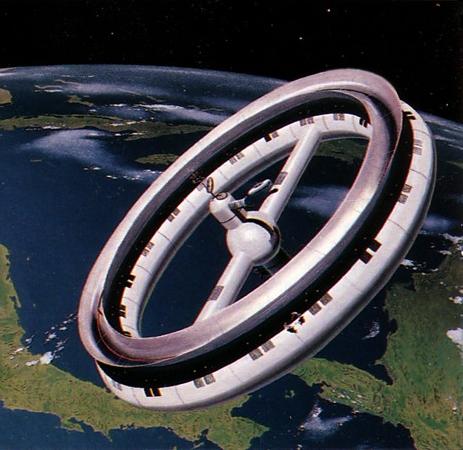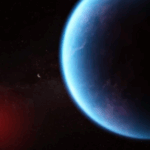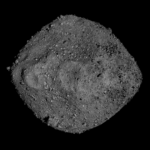October 2, 2014 – The scene of the rotating space station from 2001: A Space Odyssey reminds me of just how much further we need to go in 2014 to achieve that science fiction dream. What’s holding us back from building a spinning station that creates artificial gravity, like the one envisioned by Arthur C. Clarke and by the builder of America’s Saturn V rocket, Wernher von Braun?
Rotating a human habitat in space takes away some of the medical conditions human spacefarers suffer from while in near-Earth orbit. Microgravity is tough on us. It causes decalcification in our bones. It weakens our heart and fools with our circulatory system. It causes us to lose muscle mass. It affects our vision. And it prematurely ages us.
So why not spin the International Space Station (ISS)? The solar panels would lose their ability to produce energy because they would no longer be in optimal position to gather the energy from sunlight. To create and maintain the spin we would need extra propellant and we would have to do frequent refueling. But the most obvious reason is we didn’t design the ISS to be spun. If we rotate it we put stress on its many modular components and rip it apart.
So why didn’t we design it to look like the station in 2001? For a number of reasons. The ISS is largely composed of thin-walled aluminum modules, from 1.27 millimeters (0.05 inches) to 7 millimeters (0.27 inches) thick. The air pressure from within exerts the force to keep the walls rigid. Windows on the station are thicker but not by much. To build a rotating station the materials used and thickness would have to be far greater. And when you consider current payload capacity of the rockets we have deployed in building the station, a more rigid, artificial gravity station, would have taken much longer to construct and would have been astronomically higher in cost. Consider that the partnering nations of the world spent $100 billion on building ISS, how would a higher price tag have been justified?
Payload consideration limits, however, can be overcome if we start using materials in space, rather than bringing them up from the gravity well that is Earth. That’s why future space stations may feature the space wheel design. Captured asteroids could provide ideal building materials. 3D printers in space could produce much of the component parts.
A way to get around building a rigid space wheel involves tethering two spacecraft together and rotating them around a central point along the tether. This would provide Earth equivalent gravity to the occupants of both spacecraft. Such an experiment has recently been proposed for a future crewed mission to the ISS aboard a Soyuz.
But a rotating space wheel would have considerable advantages. It could feature a central microgravity hub where humans could conduct experiments. Along each spoke radiating to the outer rim human crews could use variable gravity conditions for other forms of experiments, or even condition themselves to lower gravity in anticipation of landing on a lower gravity world like Mars.
Changing the rate of spin could also alter the gravity environment. For instance, if a spacecraft were to be built to fly to Mars and were designed to spin creating artificial gravity, at the beginning of the trip the voyagers could experience Earth gravity conditions with a higher spin rate and as the craft moved closer to its destination the spin would slow to reduce the gravity to conditions found on Mars.
Of course spinning a spacecraft also means we have to consider its size. A small spinning craft will create artificial gravity but the force and frequency of rotations will have a negative impact on those aboard. Human crews will experience disruptive changes to the fluids in the inner ear leading to disorientation and nausea. A near disaster in the flight of Gemini 8, when it rendezvoused and docked with an Atlas-Agena target, and shortly thereafter because of a stuck thruster experienced rapid spin. The spin rate was so high it almost caused the human crew to lose consciousness. If it had we would have lost Neil Armstrong, the first human to set foot on the Moon.
The other aspect of a spinning spacecraft is the strange side affect of Coriolis Force. First described by Gaspard-Gustave Coriolis in an 1835 paper, Coriolis Force is the explanation for the spinning observed in cyclonic storms like hurricanes, and in the motion of water as it drains from a sink. It is the rotation of our Earth that creates the spin effect. If Earth didn’t rotate, then storms wouldn’t spin.
Now apply this to astronaut on a spinning spaceship. Coriolis Force would act in the same way. So if the astronaut reached to press a key or icon on a screen his or her hand would be deflected and miss. It would take some getting used to on the part of a space crew to adjust to this peculiar byproduct of a spinning spacecraft.
And despite all this spinning spacecraft remain on the drawing boards at NASA. That’s because for long duration spaceflight humans are going to need artificial gravity in some form to ensure that they survive the journey. So maybe that 2001 space wheel will come about but unfortunately not on the timetable first divined by Arthur C. Clarke. My best guess is we will see artificial gravity deployed on spacecraft in the 2020s and become integrally a part of spaceship and space station design in the 2030s and beyond.












((My best guess is we will see artificial gravity deployed on spacecraft in the 2020s and become integrally a part of spaceship and space station design in the 2030s and beyond.))
That seems a plausible guess. It coincides with Kurzweil’s guess that cheap AI will reach human level in that time frame. AI is the key to competent space robots that could convert a small fraction of Phobos into human space ships/habitats. To somewhat oversimplify, the physics of 0.8g artificial gravity and human response to it requires that the wheel diameter be greater than 600 feet and the mass in the thousands of tons. At 600 feet diameter, slight Coriolis effects will be noticed. Ideally, the habitat wheel would exceed 1200 feet in diameter, spin at less than 2 rpm, and Coriolis effects would be nearly negligible. (It’s still unknown what the ideal g would be for a sustained human space habitat. It’s generally assumed that humans could live comfortably for countless generations at 0.8g. But for all we know it’s possible that even 0.4g would be enough. The lower the g force the lower the spin rate required and the smaller and lighter the wheel can be.) Even a 0.8g 600 foot diameter sub-optimal habitat with some noticeable Coriolis effects would be a huge robotic project, but we might be able to do it sometime in the 2030s. All of that argues we need to spend our space bucks on robotics and AI development, not on putting men into international space stations or on the moon. When we get the smart robots working, all else will fall into place.
As it bears heavily on the practicality of artificial gravity space habitats, the recent Chinese and NASA announcement of microwave thrust without expending reaction mass propellant is intriguing. Solar or nuclear power would allow sustained orbit and spin rate control, and, at least in principle, convert wheel-habitats into interplanetary space ships. I hope the microwave thruster really works, but I’m still very skeptical. I expect NASA will get their microwave thruster perfected about the time Rossi gets his E-Cat commercialized and seriously competing with Black Light Power hydrino energy.
Thank you Allen for putting a perspective on the dimension requirements to achieve Earth-simulated artificial gravity. I agree with you that any attempt to build such a structure would be managed by robots using materials available in space and not coming from Earth.
For humans to live in gravity half that of Earth I would guess that we would see physiological changes the body can live with over a long term. If we are to reach the 1 million living in space by 2100 (my prognostication in an earlier posting). You may want to comment on that particular piece of writing. The link is: https://www.21stcentech.com/space-humanity-21st-century-part-11-space-2100/.
((I agree with you that any attempt to build such a structure would be managed by robots using materials available in space and not coming from Earth.))
We don’t even have a theoretical scheme that seems plausible for transporting many thousands of tons from the Earth’s surface to beyond the Earth’s gravity well. As long as our thrust/lift to orbit technology depends on reaction mass, we have no known affordable technology.
But we have to get our robots out there somehow. That mass might amount to only a hundred tons or so. The robots will need tools and equipment only available from the surface, and that might amount to another couple hundred tons. All that at a minimum would have to be boosted with what now seems very expensive reactive thrust.
One can easily imagine how highly intelligent space robots might use material from asteroids or the Martian moons to self-replicate, fashion massive construction/mining/refining machinery, and build human habitats/ships in space, but its difficult to envision how robots in space might fabricate the microscopic and rare element structures that will constitute robot brains. Robots could easily do it on Earth, but not in space. (Millions of square feet of industrial space on Earth are dedicated to the fabrication of microcircuits) So it would seem considerable fabrication and material supply would have to be done on the surface, and the Earth economy would just have to bear the costly expense of reaction thrust to put it into orbit.
Kurzweil envisions nanobots that might sift through bulk asteroid dust and harvest the rare elements for micro circuit fabrication, but I’m guessing microgravity and hard radiation in space would severely limit utility of nanobots. Then too there is the practical political issue of Earth governments’ desire to keep space activities completely dependent on vital elements available only from the Earth’s surface.
It might prove most feasible to fabricate many of a space wheel ship/habitat’s structural elements from high-strength composite materials on the planet surface and pay the huge boost costs. Then let the robots do the final assembly and add most of the mass needed for radiation shielding and stability from materials found in space. One should keep in mind that space boost costs are largely based on human labor costs. Once we have smart robots, the space boost costs would likely fall dramatically. Maybe the first effort would have 2% of the final mass produced on Earth’s surface. Maybe by the 5th generation wheel ship, it would be technically possible to eliminate all trade with Earth. Without the knowledge of long-term effects on humans of reduced gravity, it’s impossible to devise an optimal plan. Although it now seems doubtful, some humans might even be able to adapt long-term to 0.1g. Then we could consider 1st generation space wheel ships only 150 feet in diameter. With our present state of ignorance it’s all a guessing game.
((For humans to live in gravity half that of Earth I would guess that we would see physiological changes the body can live with over a long term. If we are to reach the 1 million living in space by 2100 (my prognostication in an earlier posting. The link is: https://www.21stcentech.com/spa)).
Well, we just don’t know. There may be subtle, unknown, and critical, threshold effects. The project will be so expensive (unless robots perform most of the surface portion also) we can’t afford to take many chances we could get it wrong. The first wheel ship probably needs to be about 600-feet in diameter. That would give us 0.4g at 2-rpm. If it turns out humans can’t permanently sustain 0.4g, then spin rate could be increased to say 3-rpm, which would aggravate Coriolis/inner-ear effects but bring g up to 0.6. With a 600-ft wheel, some regime of alternating spin-rates every day or so would probably work. (Monday, Wednesday, and Fridays are heavy 0.8g days; Saturday, Sunday, Tuesday, and Thursdays are light 0.4g days.) A 1200-foot wheel is truly the right answer, (2.5 rpm produces 1.0g) but construction requires 8-times the time/effort/costs. If humans seem happy and healthy at 0.8g, then the spin rate could be reduced to say 1.5 rpm, and see what happens at 0.6g while enjoying a lower Coriolis factor.
0.8g could probably work forever; I’m not so sure about 0.5g. Regardless of what combination of size, spin rate, and g-force, is ultimately adopted, structural stresses will be proportional to the g level. The lower the g level, the quicker, easier, and cheaper, the wheel construction. It might turn out that radiation and micro-meteorite shielding mass will need to be so great, many thousands of tons, that the whole structure will have to be designed for 3-4g.
Few people ever think about the radiation shielding provided by our planets atmosphere, and the huge amount of mass involved. If the gaseous mass of the atmosphere were in the form of liquid water, at present sea-level we would be under about 34-feet of water. Of course there is no direct translation of radiation shielding by the gaseous atmosphere and liquid water, but you get the idea; it takes a lot of mass to produce a little shielding. It takes 3-feet of concrete to protect against prompt gamma radiation burst from a 10mt H-bomb detonated 10 miles distant. Good health in a 24/7/365 space wheel habitat will require a lot of massive shielding. The wheel structure will have to support that shielding mass at whatever artificial gravity level is selected. The first wheel habitats will likely have a few well shielded areas where the inhabitants spend most of their time; the majority of the wheel would be only minimally shielded, and the humans would spend only a fraction of their time there.
I’d like to add just a little more to my comments about space habitat scale. I might have exaggerated some of the difficulties of building an artificial gravity space habitat wheel. An arbitrary assumption that the huge radiation shielding mass would be attached to, and rotate along with, the habitat wheel has informed all my previous remarks. In principle, that would be the safest practice because it eliminates all possibility of catastrophic kinetic collision between the rotating habitat and a stationary shielding shroud, and it greatly simplifies the interplanetary ship application.
But the physical fact is the habitat wheel and its spin control system could be made much lighter and cheaper if the habitat wheel rotates independently of the massive radiation shield shroud. An axle at the habitat wheel spin axis could serve as the central anchor for lightweight “spokes” that keep the radiation shroud properly positioned and prohibit contact with the spinning habitat wheel. One could envision a relatively light-weight habitat wheel spinning within a very massive radiation shield wheel that rarely, if ever, spins relative to the stars. No part of the spinning habitat wheel would be significantly stressed to support the huge weightless mass of the radiation shroud.
Many difficult judgment call decisions must be made before design work begins. It is sort of like the decisions that were made prior to building the Fukushima nuclear power plant. It would have been safer to build the power plant much further inland, and build another power plant just for emergency control even further inland than that. But of course that would have greatly raised construction costs. How safe is safe enough?
My guess is the first space wheel will have a stationary radiation shroud and all the complex controls and adjustments will be handled by smart robots. But it won’t be as safe as a wheel with integral shielding mass.
Under the laws of motion of the body in celestial mechanics, each closed lower body rotation around a larger (except circular motion) must have its own spin, whether you wanted it or not. Spin formed from one part of the kinetic energy of the radial velocity, which is variable in function of the changes in the path of rotation of a radius about lower larger bodies. In this case, the gravity of the body is as large as the corresponding gravity to place in the solar system. If you want to change the gravity, it can be done additional kinetic energy of rotation about its own axis, but then it changed and all other conditions of movement: the centrifugal force, Coriolis acceleration, all phenomena related to moving with more energy for increased spin.